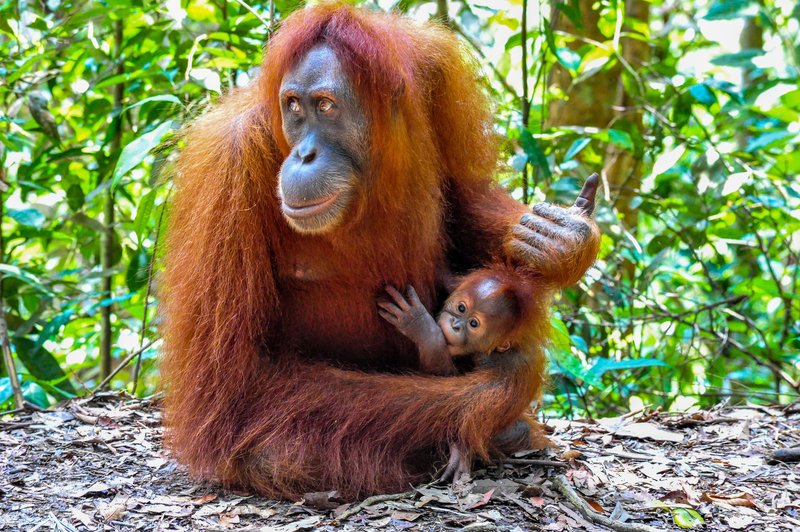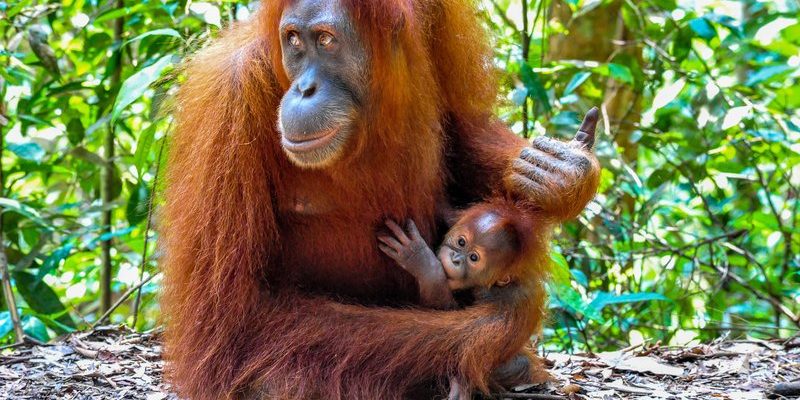
The Sumatran orangutan is one of our closest relatives in the animal kingdom, sharing about 97% of its DNA with humans. This connection makes understanding their evolutionary history not just a scientific endeavor but a deeply personal one, reminding us of our ties to the earth’s diverse life forms. So, how did the Sumatran orangutan come to be? Let’s dive into their evolutionary timeline and see what makes this species so special.
Origins of the Great Apes
To really grasp the evolutionary history of the Sumatran orangutan, it’s essential to start at the beginning. The great apes, including orangutans, gorillas, and chimpanzees, branched off from a common ancestor with humans approximately 5 to 7 million years ago. This was a significant moment, as it marked the start of a long and intricate journey.
The first orangutans likely appeared around 12 to 16 million years ago during the Miocene epoch. During this era, the earth experienced significant climatic changes that created suitable habitats for these early apes in Southeast Asia. As the forests flourished, early orangutans adapted to a life in the trees, developing their remarkable brachiating abilities—swinging from branch to branch with grace and agility.
Interestingly, orangutans faced numerous challenges during their evolution. Changes in climate and habitat, competition for food, and even the emergence of new predators pushed them to adapt in ways that would further differentiate them from their cousins and ancestors.
The Split Between Sumatran and Bornean Orangutans
As evolution progressed, the orangutans began to diverge into different species. The Sumatran orangutan and its close relative, the Bornean orangutan, split from their common ancestor around 400,000 years ago. This split is significant—it created two distinct species with unique adaptations.
The Sumatran orangutan has a few distinct traits that set it apart. For one, it has a slightly smaller body size compared to the Bornean orangutan. You might also notice that Sumatran orangutans have longer faces and a more pronounced cheek pad in mature males. These differences play an essential role in their mating behaviors and social structures.
Habitat also played a crucial role in shaping the Sumatran orangutan’s evolution. Found only in the rainforests of Sumatra, these orangutans adapted to a diet rich in fruit, particularly the durian. This reliance on specific food sources influenced not only their physical characteristics but also their behavior, contributing to their solitary lifestyle—unlike some social mammals that thrive in groups.
Adaptations to Rainforest Life
The dense rainforests of Sumatra are an ever-changing environment, and the Sumatran orangutan has developed remarkable adaptations to survive here. Their long, powerful arms are perfect for swinging through the treetops, allowing them to cover large distances in search of food. Imagine a well-trained gymnast climbing a set of uneven bars—that’s what these orangutans do with finesse.
Their strong grasp helps them manipulate branches to reach delicious fruits and leaves. The orangutan’s flexible diet is a significant factor in its survival, as it can feast on over 400 types of fruit. This diversity ensures that they can adapt to seasonal changes in food availability, something crucial for life in the rainforest.
Additionally, their bright orange fur isn’t just for looks. This coloration helps them blend in with the sunlight filtering through the leaves, providing them with a natural camouflage against potential predators. It’s nature’s way of keeping them safe while they navigate their arboreal world.
The Role of Sumatran Orangutans in Ecosystems
Sumatran orangutans play a vital role in their ecosystem, acting as key players in the health of their rainforest habitat. As they travel through trees, they feast on fruits and then disperse the seeds throughout their travels. This seed dispersal is crucial for maintaining healthy forest growth.
In fact, without orangutans, certain tree species would struggle to reproduce, leading to a ripple effect throughout the ecosystem. It’s like having a gardener in the forest, nurturing the environment and encouraging growth. Their role as seed dispersers emphasizes the interconnectedness of species in the rainforests and highlights the importance of conserving their habitat.
Unfortunately, habitat destruction from logging and agriculture threatens their survival. When forests are cleared, not only do orangutans lose their homes, but entire ecosystems begin to crumble. This underscores how the evolutionary journey of the Sumatran orangutan isn’t just about survival—it’s also about preserving the delicate balance of life that depends on them.
Conservation Efforts and Future Challenges
As we’ve learned, the Sumatran orangutan is a species that has evolved over millions of years, but its future hangs in the balance. Conservation efforts are critical to ensuring that these incredible creatures don’t become just a memory. NGOs and local communities are working hard to protect their habitats through sustainable practices and anti-logging initiatives.
One successful approach has been the creation of wildlife reserves. These protected areas provide a safe haven for orangutans and other wildlife, allowing them to thrive without the encroachment of human activity. Additionally, education programs aim to raise awareness about the importance of preserving orangutans and their habitats.
However, challenges remain. Illegal logging, poaching, and climate change continue to threaten their existence. Addressing these issues requires cooperation at local, national, and global levels. It’s a complex puzzle that needs all hands on deck to solve, but with concerted efforts, we can help keep the Sumatran orangutan swinging through the trees for generations to come.
A Glimpse into the Future: The Importance of Preservation
Looking ahead, the evolutionary history of the Sumatran orangutan reminds us of the importance of biodiversity. Each species has its own story, and when we protect them, we also protect the intricate web of life they belong to.
Protecting orangutans isn’t just about saving one species; it’s about preserving diverse ecosystems that sustain life on earth. By advocating for the Sumatran orangutan, we’re taking a stand for the planet’s health and ensuring that future generations will also be able to appreciate these amazing creatures.
In conclusion, the Sumatran orangutan’s evolutionary journey is a testament to resilience and adaptability. From their origins millions of years ago to the challenges they face today, these remarkable creatures have a story worth preserving. Let’s work together to make sure their future is as bright as their vibrant fur.

